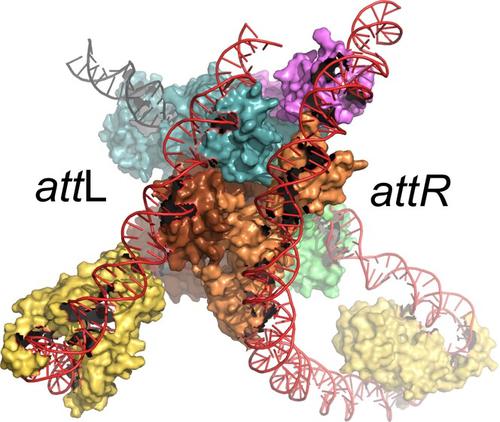当前位置:
X-MOL 学术
›
Mol. Microbiol.
›
论文详情
Our official English website, www.x-mol.net, welcomes your feedback! (Note: you will need to create a separate account there.)
Bacteriophage lambda site‐specific recombination
Molecular Microbiology ( IF 3.6 ) Pub Date : 2024-02-19 , DOI: 10.1111/mmi.15241 Gregory D. Van Duyne 1 , Arthur Landy 2
Molecular Microbiology ( IF 3.6 ) Pub Date : 2024-02-19 , DOI: 10.1111/mmi.15241 Gregory D. Van Duyne 1 , Arthur Landy 2
Affiliation

|
The site‐specific recombination pathway of bacteriophage λ encompasses isoenergetic but highly directional and tightly regulated integrative and excisive reactions that integrate and excise the vial chromosome into and out of the bacterial chromosome. The reactions require 240 bp of phage DNA and 21 bp of bacterial DNA comprising 16 protein binding sites that are differentially used in each pathway by the phage‐encoded Int and Xis proteins and the host‐encoded integration host factor and factor for inversion stimulation proteins. Structures of higher‐order protein–DNA complexes of the four‐way Holliday junction recombination intermediates provided clarifying insights into the mechanisms, directionality, and regulation of these two pathways, which are tightly linked to the physiology of the bacterial host cell. Here we review our current understanding of the mechanisms responsible for regulating and executing λ site‐specific recombination, with an emphasis on key studies completed over the last decade.
中文翻译:

噬菌体 lambda 位点特异性重组
噬菌体 λ 的位点特异性重组途径包括等能量但高度定向且严格调控的整合和切除反应,将小瓶染色体整合到细菌染色体中或从细菌染色体中切除。该反应需要 240 bp 的噬菌体 DNA 和 21 bp 的细菌 DNA,其中包含 16 个蛋白结合位点,噬菌体编码的 Int 和 Xis 蛋白以及宿主编码的整合宿主因子和反转刺激蛋白因子在每个途径中都有不同的使用。四路霍利迪连接体重组中间体的高阶蛋白质-DNA复合物的结构为这两条途径的机制、方向性和调节提供了澄清的见解,这两条途径与细菌宿主细胞的生理学紧密相关。在这里,我们回顾了目前对调节和执行 λ 位点特异性重组机制的理解,重点是过去十年完成的关键研究。
更新日期:2024-02-19
中文翻译:

噬菌体 lambda 位点特异性重组
噬菌体 λ 的位点特异性重组途径包括等能量但高度定向且严格调控的整合和切除反应,将小瓶染色体整合到细菌染色体中或从细菌染色体中切除。该反应需要 240 bp 的噬菌体 DNA 和 21 bp 的细菌 DNA,其中包含 16 个蛋白结合位点,噬菌体编码的 Int 和 Xis 蛋白以及宿主编码的整合宿主因子和反转刺激蛋白因子在每个途径中都有不同的使用。四路霍利迪连接体重组中间体的高阶蛋白质-DNA复合物的结构为这两条途径的机制、方向性和调节提供了澄清的见解,这两条途径与细菌宿主细胞的生理学紧密相关。在这里,我们回顾了目前对调节和执行 λ 位点特异性重组机制的理解,重点是过去十年完成的关键研究。



























 京公网安备 11010802027423号
京公网安备 11010802027423号